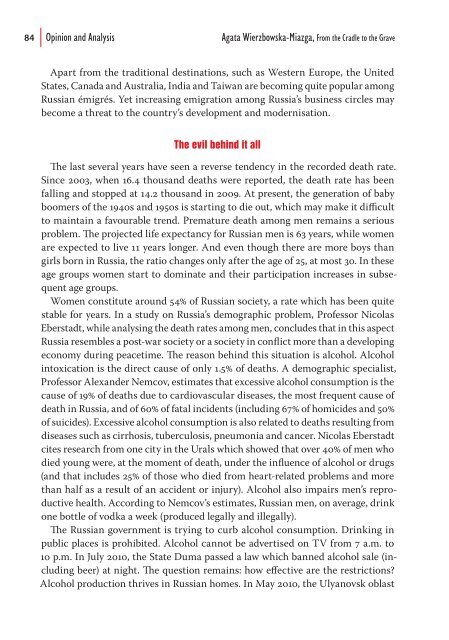Create successful ePaper yourself
Turn your PDF publications into a flip-book with our unique Google optimized e-Paper software.
84<br />
Opinion and Analysis Agata Wierzbowska-Miazga, From the Cradle to the Grave<br />
Apart from the traditional destinations, such as Western <strong>Europe</strong>, the United<br />
States, Canada and Australia, India and Taiwan are becoming quite popular among<br />
Russian émigrés. Yet increasing emigration among Russia’s business circles may<br />
become a threat to the country’s development and modernisation.<br />
The evil behind it all<br />
Th e last several years have seen a reverse tendency in the recorded death rate.<br />
Since 2003, when 16.4 thousand deaths were reported, the death rate has been<br />
falling and stopped at 14.2 thousand in 2009. At present, the generation of baby<br />
boomers of the 1940s and 1950s is starting to die out, which may make it diffi cult<br />
to maintain a favourable trend. Premature death among men remains a serious<br />
problem. Th e projected life expectancy for Russian men is 63 years, while women<br />
are expected to live 11 years longer. And even though there are more boys than<br />
girls born in Russia, the ratio changes only after the age of 25, at most 30. In these<br />
age groups women start to dominate and their participation increases in subsequent<br />
age groups.<br />
Women constitute around 54% of Russian society, a rate which has been quite<br />
stable for years. In a study on Russia’s demographic problem, Professor Nicolas<br />
Eberstadt, while analysing the death rates among men, concludes that in this aspect<br />
Russia resembles a post-war society or a society in confl ict more than a developing<br />
economy during peacetime. Th e reason behind this situation is alcohol. Alcohol<br />
intoxication is the direct cause of only 1.5% of deaths. A demographic specialist,<br />
Professor Alexander Nemcov, estimates that excessive alcohol consumption is the<br />
cause of 19% of deaths due to cardiovascular diseases, the most frequent cause of<br />
death in Russia, and of 60% of fatal incidents (including 67% of homicides and 50%<br />
of suicides). Excessive alcohol consumption is also related to deaths resulting from<br />
diseases such as cirrhosis, tuberculosis, pneumonia and cancer. Nicolas Eberstadt<br />
cites research from one city in the Urals which showed that over 40% of men who<br />
died young were, at the moment of death, under the infl uence of alcohol or drugs<br />
(and that includes 25% of those who died from heart-related problems and more<br />
than half as a result of an accident or injury). Alcohol also impairs men’s reproductive<br />
health. According to Nemcov’s estimates, Russian men, on average, drink<br />
one bottle of vodka a week (produced legally and illegally).<br />
Th e Russian government is trying to curb alcohol consumption. Drinking in<br />
public places is prohibited. Alcohol cannot be advertised on TV from 7 a.m. to<br />
10 p.m. In July 2010, the State Duma passed a law which banned alcohol sale (including<br />
beer) at night. Th e question remains: how eff ective are the restrictions?<br />
Alcohol production thrives in Russian homes. In May 2010, the Ulyanovsk oblast



